Extended Calix[4]arene-Based Receptors for Molecular Recognition and Sensing
Abstract
:1. Introduction
2. Molecular Recognition Based upon Extended Calix[4]arenes
2.1. Extended Calix[4]arene-Based Receptors for Cations

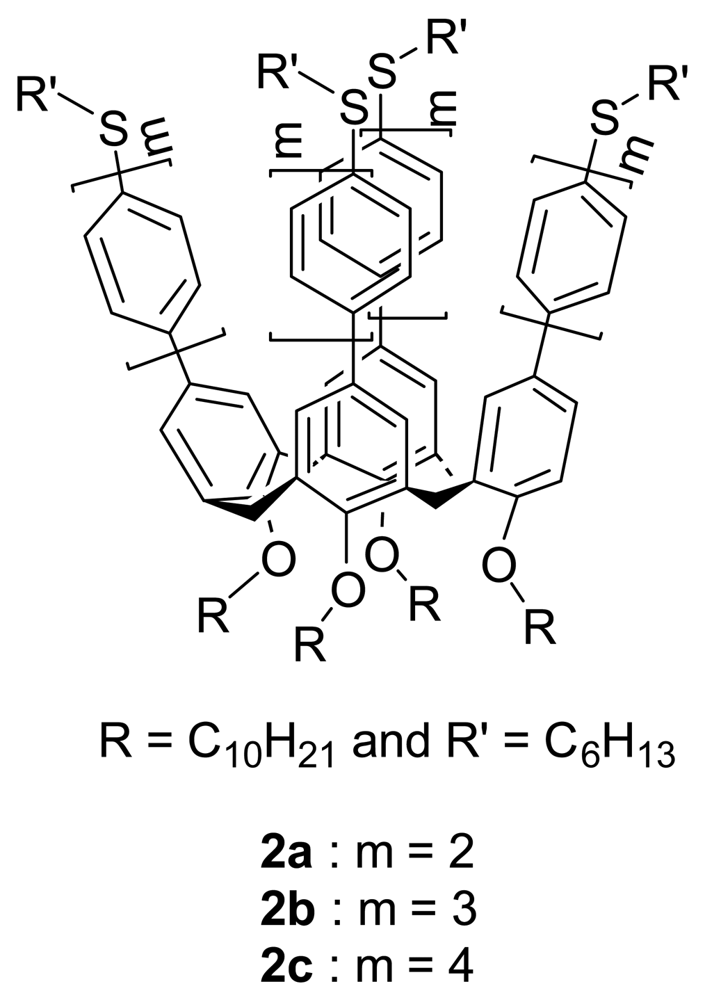

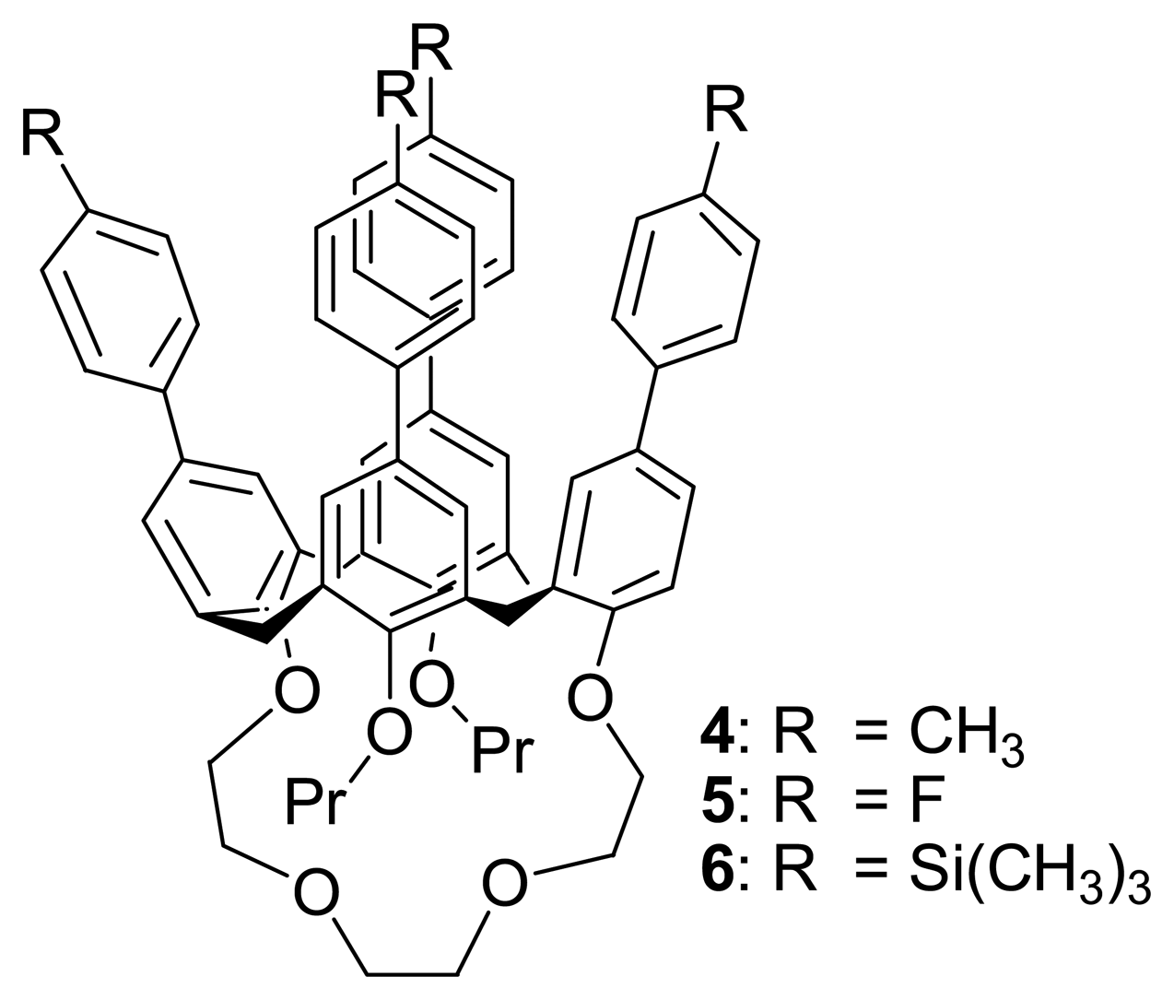
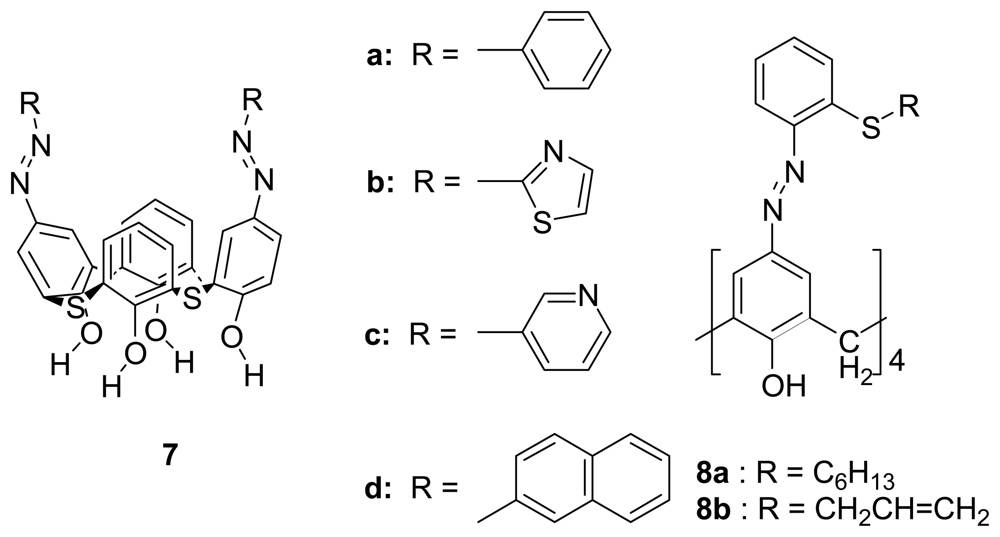
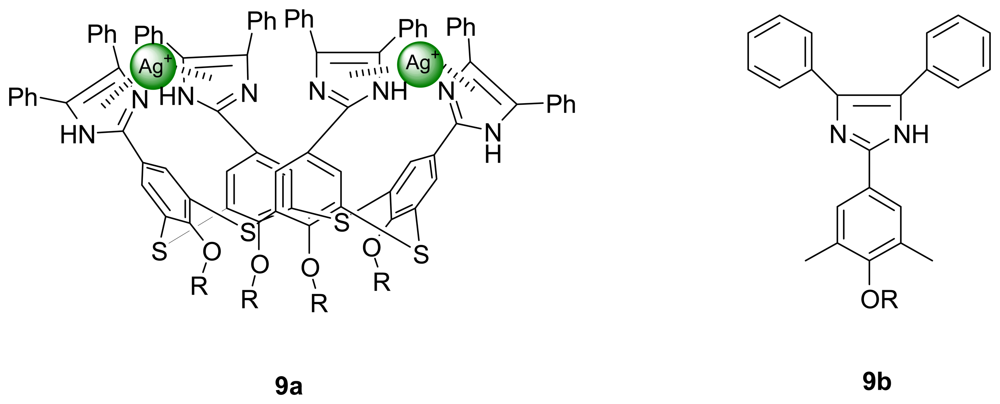
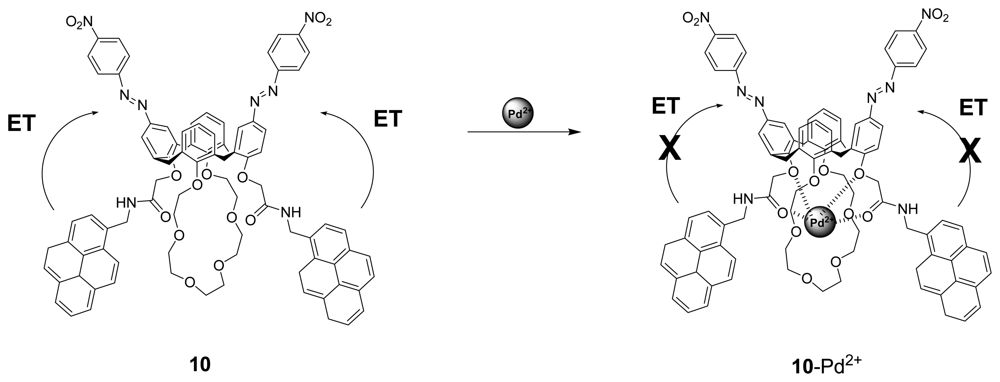
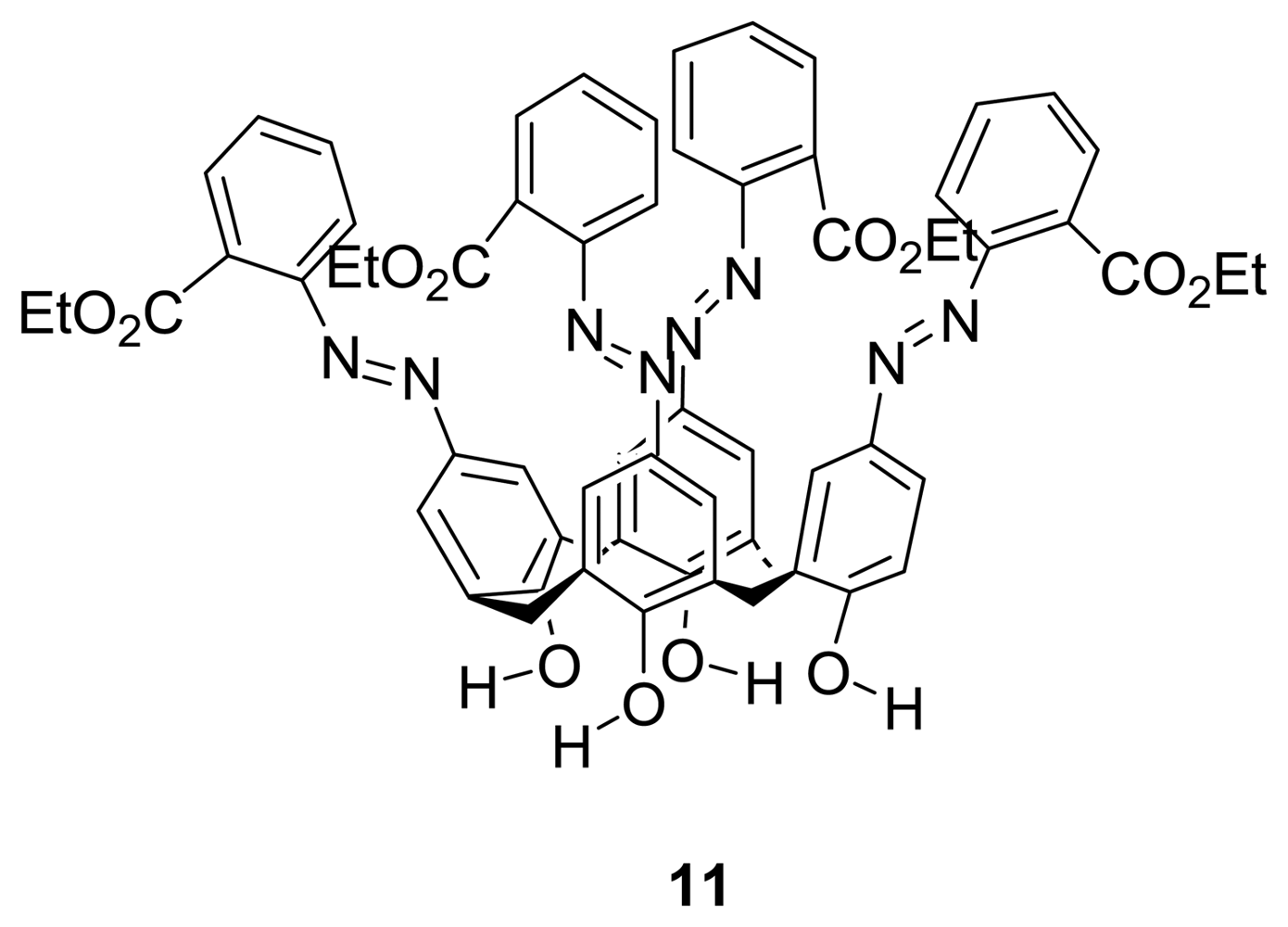
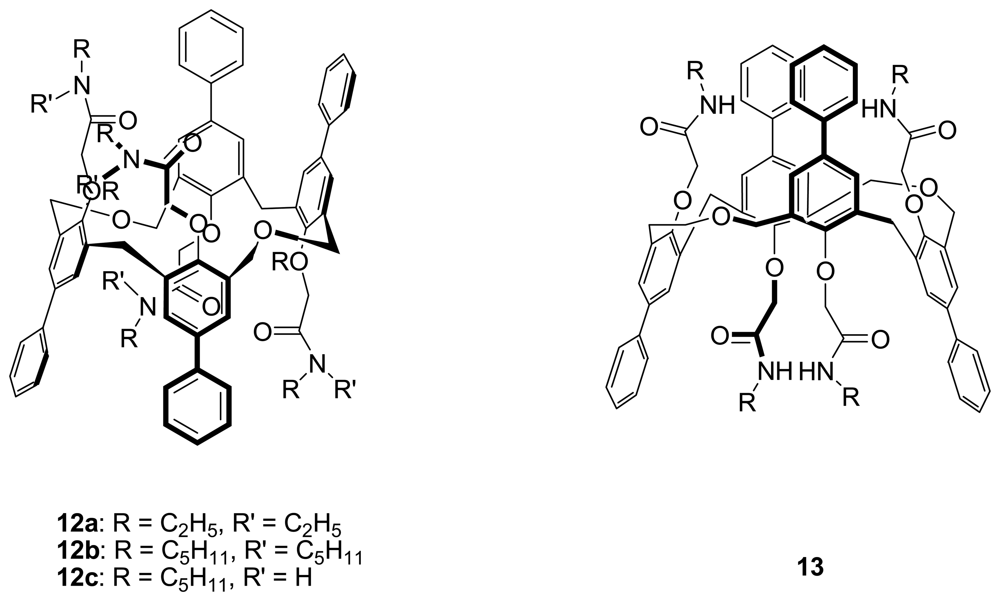



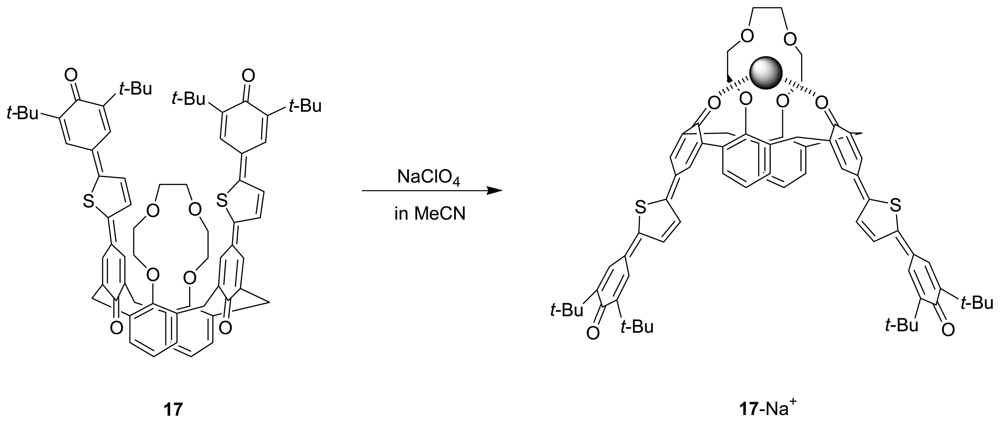
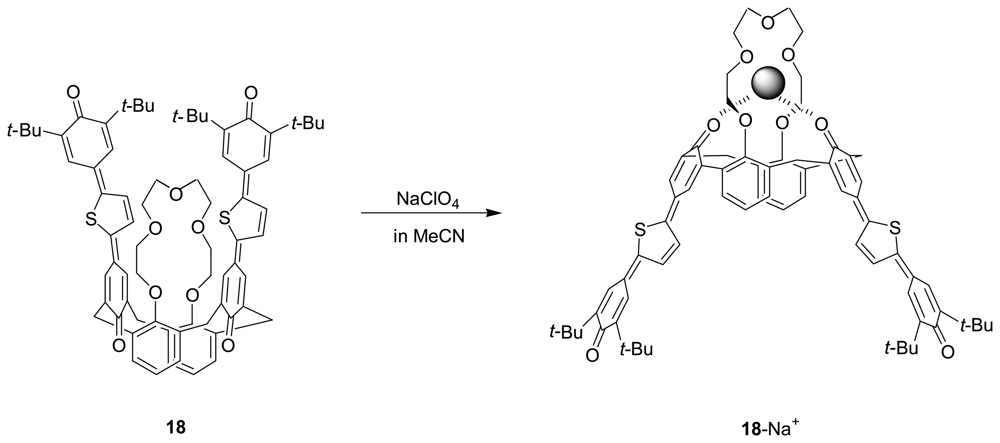
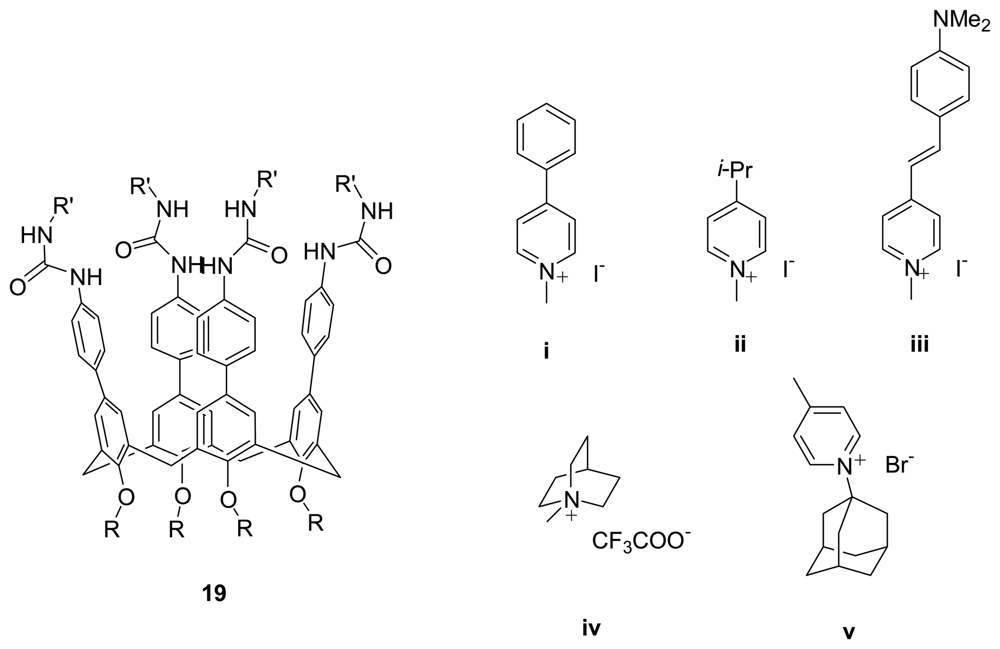
2.2. Extended Calix[4] arene-Based Receptors for Anions
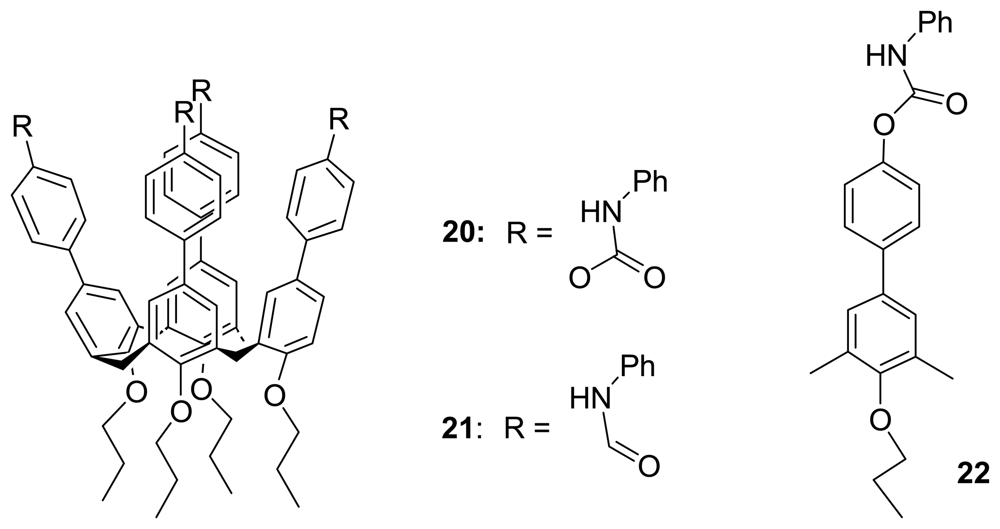
2.3. Extended Calix[4]arene-Based Receptors for Neutral Molecules
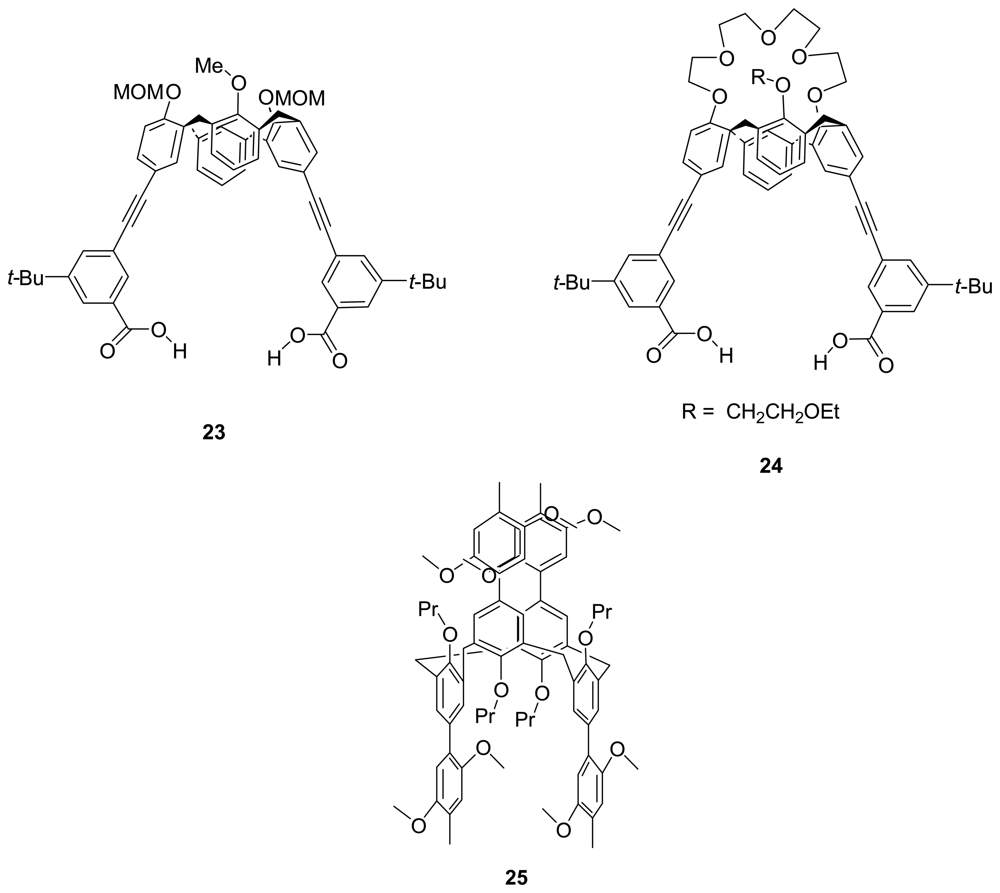
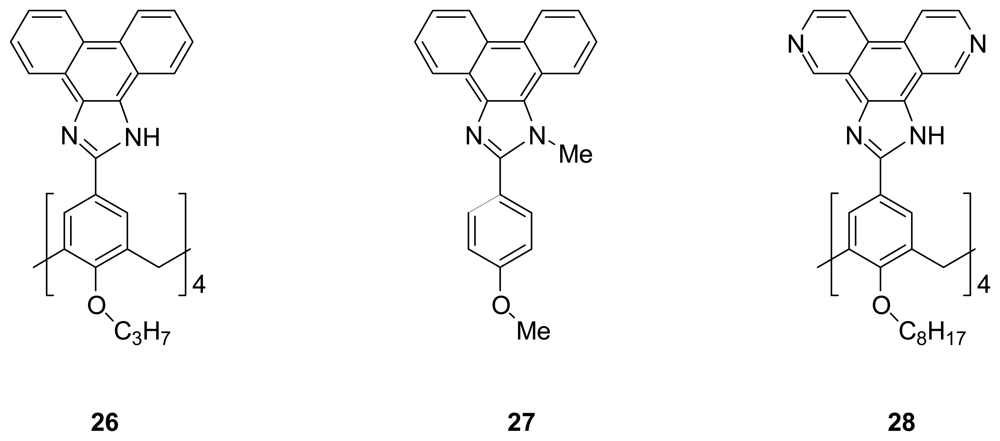
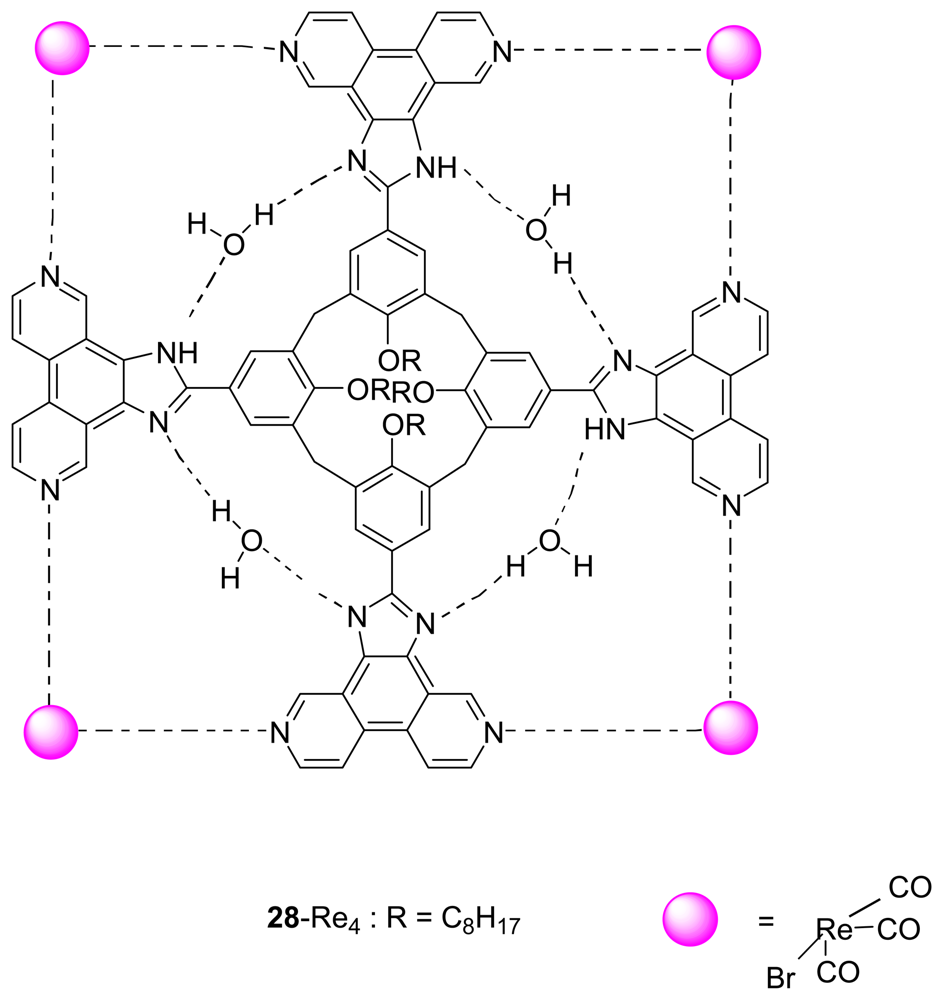
3. Conclusions
4. References
- Haugland, R.P. The Handbook. A Guide to Fluorescent Probes and Labeling Technologies, 10th Ed. ed; Molecular Probes Inc.: Eugene, OR, 2005. [Google Scholar]
- Stibor, I. Anion sensing; Springer-Verlag: Berlin, 2005. [Google Scholar]
- Martinez-Manez, R.; Sancenon, F. Fluorogenic and Chromogenic Chemosensors and Reagents for Anions. In Chem. Rev.; (Washington, DC, U. S.), 2003; Volume 103, pp. 4419–4476. [Google Scholar]
- Beer, P.D.; Gale, P.A. Anion Recognition and Sensing: The State of the Art and Future Perspectives. Angew. Chem. Int. Ed. 2001, 40, 486–516. [Google Scholar]
- Haryley, J.H.; James, T.D.; Ward, C.J. Synthetic Receptors. J. Chem. Soc. Perkin Trans. 2000, 1, 3155–3184. [Google Scholar]
- de Silva, A.P.; Nimal Gunaratne, H.Q.; Gunnlaugsson, T.; Huxley, A.J.M.; Mccoy, C.P.; Rademacher, J.T.; Rice, T.E. Signaling Recognition Events with Fluorescent Sensors and Switches. Chem. Rev. 1997, 97, 1515–1566. [Google Scholar]
- Czarnik, A.W. Fluorescent Chemosensors for Ion and Molecule Recognition. Proceedings of American Chemical Society, Washington, DC; 1993. [Google Scholar]
- Matthews, S.E.; Beer, P.D. Calixarene-based Anion Receptors. Supramol. Chem. 2005, 17, 411–435. [Google Scholar]
- Desvergne, J.P.; Czarnik, A.W. Chemosensors of Ion and Molecule Recognition; Kluwer Academic Publishers: Dordrecht, Boston, London, 1997. [Google Scholar]
- Czarnik, A.W. Fluorescent Chemosensors for Ion and Molecule Recognition. Proceedings of American Chemical Society; ACS: Washington, DC, 1992. [Google Scholar]
- Kim, S.K.; Lee, J.K.; Lee, S.H.; Lim, M.S.; Lee, S.W.; Sim, W.; Kim, J.S. Silver Ion Shuttling in the Trimer-Mimic Thiacalix[4]crown Tube. J. Org. Chem. 2004, 69, 2877–2880. [Google Scholar]
- Budka, J.; Lhoták, P.; Stibor, I.; Michlová, V.; Sykroa, J.; Cisarová, I. A Biscalix[4]arene-Based Ditopic Hard/Soft Receptor for K+/Ag+ Complexation. Tetrahedron Lett. 2002, 43, 2857–2861. [Google Scholar]
- Metivier, R.; Leray, I.; Valeur, B. Lead and Mercury Sensing by Calixarene-Based Fluoroionophores Bearing Two or Four Dansyl Fluorophores. Chem. Eur. J. 2004, 10, 4480–4490. [Google Scholar]
- Kim, J.H.; Hwang, A.R.; Chang, S.K. Hg2+-Selective Fluoroionophore of p-Tert-Butylcalix[4]arene-Diaza-Crown Ether having Pyrenylacetamide Subunits. Tetrahedron Lett. 2004, 45, 7557–7561. [Google Scholar]
- Choi, M.J.; Kim, M.Y.; Chang, S.K. A New Hg2+-Selective Chromoionophore Based on Calix[4]arenediazacrown Ether. Chem. Commun. 2001, 1664–1665. [Google Scholar]
- Hanaoka, K.; Kikuchi, K.; Kojima, H.; Urano, Y.; Nagano, T. Development of a Zinc Ion-Selective Luminescent Lanthanide Chemosensor for Biological Applications. J. Am. Chem. Soc. 2004, 126, 12470–12476. [Google Scholar]
- Chen, P.; Greenberg, B.; Taghavi, S.; Romano, C.; vander Lelie, D.; He, C. An Exceptionally Selective Lead (II) Regulatory Protein from Ralstonia Metallidurans: Development of a Fluorescent Lead(II) Probe. Angew. Chem. Int. Ed. 2005, 44, 2715–2719. [Google Scholar]
- Tomapatanaget, B.; Tuntulani, T.; Chailapakul, O. Calix[4]arenes Containing Ferrocene Amide as Carboxylate Anion Receptors and Sensors. Org. Lett. 2003, 5, 1539–1542. [Google Scholar]
- Kim, S.K.; Bok, J.H.; Bartsch, R.A.; Lee, J.Y.; Kim, J.S. A Fluoride-Selective PCT Chemosensor Based on Formation of a Static Pyrene Excimer. Org. Lett. 2005, 7, 4839–4842. [Google Scholar]
- Kang, S.O.; Begum, R.A.; Bowman-James, K. Continuous Fluorometric Assays for Acetylcholinesterase Activity and Inhibition with Conjugated Polyelectrolytes. Angew. Chem. Int. Ed. 2007, 45, 7882–7886. [Google Scholar]
- Kang, S.O.; Hossain Md, A.; Bowman-James, K. Influence of dimensionality and charge on anion binding in amide-based macrocyclic receptors. Coord. Chem. Rev. 2006, 250, 3038–3052. [Google Scholar]
- Lin, C.; Simov, V.; Drueckhammer, D.G. Interaction of Halide and Carboxylate Ions with 4,5-Diacetamidoacridine-9(10H)-one: Thermodynamics of Association and Deprotonation Events. J. Org. Chem. 2007, 72, 1742–1746. [Google Scholar]
- Massimo, B.; Boca, D.L.; Gómez, D.E.; Fabbrizzi, L.; Licchelli, M.; Monzani, E. Nature of Urea-Fluoride Interaction: Incipient and Definitive Proton Transfer. J. Am. Chem. Soc. 2004, 126, 16507–16514. [Google Scholar]
- Dudic, M.; Lhoták, P.; Stibor, I.; Lang, K.; Prosková, P. Calix[4]arene-Porphyrin Conjugates as Versatile Molecular Receptors for Anions. Org. Lett. 2003, 5, 149–152. [Google Scholar]
- Pfeffer, F.M.; Gunnlaugsson, T.; Jensen, P.; Kruger, P.E. Anion Recognition Using Preorganized Thiourea Functionalized [3] Polynorbornane Receptors. Org. Lett. 2005, 7, 5357–5360. [Google Scholar]
- Liu, S.Y.; Fang, L.; He, Y.B.; Chan, W.H.; Yeung, K.T.; Cheng, Y.K.; Yang, R.H. Cholic-Acid-Based Fluorescent Sensor for Dicarboxylates and Acidic Amino Acids in Aqueous Solutions. Org. Lett. 2005, 7, 5825–5828. [Google Scholar]
- Gunnlaugsson, T.; Davis, A.P.; Glynn, M. Fluorescent Photoinduced Electron Transfer (PET) Sensing of Anions Using Charge Neutral Chemosensors. Chem. Commun. 2001, 2556–2557. [Google Scholar]
- Gunnlaugsson, T.; Davis, A.P.; Hussey, G.M.; Tierney, J.; Glynn, M. Design, Synthesis and Photophysical Studies of Simple Fluorescent Anion PET Sensors Using Charge Neutral Thiourea Receptors. Org. Biomol. Chem. 2004, 2, 1856–1863. [Google Scholar]
- Gunnlaugsson, T.; Davis, A.P.; O'Brien, J.E.; Glynn, M. Fluorescent Sensing of Pyrophosphate and Bis-carboxylates with Charge Neutral PET Chemosensors. Org. Lett. 2002, 4, 2449. [Google Scholar]
- Gunnlaugsson, T.; Davis, A.P.; O'Brien, J.E.; Glynn, M. Synthesis and Photophysical Evaluation of Charge Neutral Thiourea or Urea Based Fluorescent PET Sensors for Bis-carboxylates and Pyrophosphate. Org. Biomol. Chem. 2005, 3, 48–56. [Google Scholar]
- Pfeffer, F.M.; Buschgens, A.M.; Barnett, N.W.; Gunnlaugsson, T.; Kruger, P.E. 4-Amino-1,8-naphthalimide-Based Anion Receptors: Employing the Naphthalimide N–H Moiety in the Cooperative binding of Dihydrogenphosphate. Tetrahedron Lett. 2005, 46, 6579–6584. [Google Scholar]
- dos Santos, C.M.G.; McCabe, T.; Gunnlaugsson, T. Selective Fluorescent Sensing of Chloride. Tetrahedron Lett. 2007, 48, 3135–3139. [Google Scholar]
- Evans, L.S.; Gale, P.A.; Light, M.E.; Quesada, R. Anion Binding vs. Deprotonation in Colorimetric Pyrrolylamidothiourea Based Anion Sensors. Chem. Commun. 2006, 965–967. [Google Scholar]
- Evans, L.S.; Gale, P.A.; Light, M.E.; Quesada, R. Pyrrolylamidourea Based Anion Receptors. New. J. Chem. 2006, 30, 1019–1025. [Google Scholar]
- Wu, F.Y.; Li, Z.; Guo, L.; Wang, X.; Lin, M.H.; Zhao, Y.F.; Jiang, Y.B. A Unique NH-Spacer for N-Benzamidothiourea Based Anion Sensors. Substituent Effect on Anion Sensing of the ICT Dual Fluorescent N-(p-Dimethylaminobenzamido)-N-arylthioureas. Org. Biomol. Chem. 2006, 4, 624–630. [Google Scholar]
- Nie, L.; Li, Z.; Han, J.; Zhang, X.; Yang, R.; Liu, W.X.; Wu, F.Y.; Xie, J.W.; Zhao, Y.F.; Jiang, Y.B. Development of N-Benzamidothioureas as a New Generation of Thiourea-Based Receptors for Anion Recognition and Sensing. J. Org. Chem. 2004, 69, 6449. [Google Scholar]
- Quinlan, E.; Matthews, S.E.; Gunnlaugsson, T. Anion Sensing Using Colorimetric Amidourea Based Receptors Incorporated into a 1,3-Disubstituted Calix[4]arene. Tetrahedron Lett. 2006, 47, 9333–9338. [Google Scholar]
- Matsumoto, H.; Shinkai, S. Metal-Induced Conformational Change in Pyrene-Appended Calix[4]crown-4 Which is Useful for Metal Sensing and Guest Tweezing. Tetrahedron Lett. 1996, 37, 77–80. [Google Scholar]
- Ghidini, E.; Ugozzoli, F.; Ungaro, R.; Harkema, S.; El-Fadl, A.A.; Reinboudt, D.N. Complexation of Alkali Metal Cations by Conformationally Rigid, Stereoisomeric Calix[4]arene Crown Ethers: a Quantitative Evaluation of Preorganization. J. Am. Chem. Soc. 1990, 112, 6979–6985. [Google Scholar]
- Narita, M.; Higuchi, Y.; Hamada, F.; Kumagai, H. Metal Sensor of Water Soluble Dansyl-Modified Thiacalix[4]arenes. Tetrahedron Lett. 1998, 54, 8687–8690. [Google Scholar]
- Kim, J.S.; Shon, O.J.; Rim, J.A.; Kim, S.K.; Yoon, J. Pyrene-Armed Calix[4]azacrowns as New Fluorescent Ionophores: “Molecular Taekowndo” Process via Fluorescence Change. J. Org. Chem. 2002, 67, 2348–2351. [Google Scholar]
- Kim, J.S.; Noh, K.H.; Lee, S.H.; Kim, S.K.; Yoon, J. Molecular Taekwondo. A New Calix[4]azacrown Bearing Two Different Binding Sites as a New Fluorescent Ionophore. J. Org. Chem. 2003, 68, 597–600. [Google Scholar]
- Leray, I.; O'Reilly, F.; Habib Jiwan, J.-L.; Soumillion, J.-Ph.; Valeur, B. A New Calix[4]Arene-Based Fluorescent Sensor for Sodium Ion. Chem. Commun 1999, 795–796. [Google Scholar]
- Nabeshima, T.; Saiki, T.; Iwabuchi, J.; Akine, S. Stepwise and Dramatic Enhancement of Anion Recognition with a Triple-Site Receptor Based on the Calix[4]arene Framework Using Two Different Cationic Effectors. J. Am. Chem. Soc. 2005, 127, 5507–5511. [Google Scholar]
- McMahon, G.; O' Malley, S.; Nolan, K. Important Calixarene Derivatives – their Synthesis and Applications. ARKIVOC 2003, vii, 23–31. [Google Scholar]
- Leray, I.; Lefevre, J.-P.; Delouis, J-F.; Delaire, J.; Valeur, B. Synthesis and Photophysical and Cation-Binding Properties of Mono- and Tetranaphthylcalix[4]arenes as Highly Sensitive and Selective Fluorescent Sensors for Sodium. Chem. Eur. J. 2001, 7, 4590–4598. [Google Scholar]
- Metzer, A.; Gloe, K.; Stephan, H.; Schmidtchen, F.P. Molecular Recognition and Phase Transfer of Underivatized Amino Acids by a Foldable Artificial Host. J. Org. Chem. 1996, 61, 2051–2055. [Google Scholar]
- Breccia, P.; Van Gool, M.; Pérez- Fernánedz, R.; Martín-Santamaria, S.; Gago, F.; Prados, P.; de Mendoza, J. Guanidinium Receptors as Enantioselective Amino Acid Membrane Carriers. J. Am. Chem. Soc. 2003, 125, 8270–8284. [Google Scholar]
- Amendola, V.; Boiocchi, M.; Fabbarizzi, L.; Palchetti, A. Anion Receptors Containing -NH Binding Sites: Hydrogen-Bond Formation or Neat Proton Transfer. Chem. Eur. J. 2005, 11, 120–127. [Google Scholar]
- Wright, A.T.; Anslyn, E.V. Cooperative Metal-Coordination and Ion Pairing in Tripeptide Recognition. Org. Lett. 2004, 6, 1341–1344. [Google Scholar]
- Gutsche, C.D. Calixarenes.; Royal Society of Chemistry: Cambridge, UK, 1989. [Google Scholar]
- Gutsche, C.D. Calixarenes Revisited.; Royal Society of Chemistry: Cambridge, UK, 1998. [Google Scholar]
- Vicens, J.; Böhmer, V. Calixarenes: Versatile Class of Macrocyclic Compounds.; Kluwer Academic Publishers: Dordrecht, Boston, London, 1991. [Google Scholar]
- Vicens, J.; Asfari, Z.; Harrowfield, J.M. Calixarenes 50th Anniversary: Commemorative Issue.; Kluwer Academic Publishers: Dordrecht, Boston, London, 1994. [Google Scholar]
- Asfari, Z.; Böhmer, V.; Harrowfield, J.M.; Vincens, J. Calix[4] arenes 2001.; Kluwer Academic Publishers: Dordrecht, Boston, London, 2001. [Google Scholar]
- Diamond, D.; McKervey, M.A. Calixarene-Based Sensing Agents. Chem. Soc. Rev. 1996, 25, 15–24. [Google Scholar]
- Chawla, H.M.; Pant, N.; Srivastava, B.; Upreti, S. Convenient Direct Synthesis of Bisformylated Calix[4]arenes via Ipso Substitution. Org. Lett. 2006, 8, 2237–2240. [Google Scholar]
- Chawla, H.M.; Pant, N.; Srivastava, B. Regioselective Ipso Formylation of p-Tert-Butylcalix[4]arene. Tetrahedron Lett. 2005, 46, 7259–7262. [Google Scholar]
- Arora, V.; Chawla, H.M.; Hundal, G. X-ray Crystal and Molecular Structure of Upper Rim Monoformylated Calix[4]arene System. J. Chem. Cryst. 2004, 34, 465–469. [Google Scholar]
- Kumar, S.; Varadarajan, R.; Chawla, H.M.; Hundal, G.; Hundal, M.S. Preparation of p-Nitrocalix[n]arene Methyl Ethers via Ipso-Nitration and Crystal Structure of Tetramethoxytetra-p-Nitrocalix[4]arene. Tetrahedron 2004, 60, 1001–1005. [Google Scholar]
- Böhmer, V. Calixarenes, Macrocycles with (Almost) Unlimited Possibilities. Angew. Chem. Int. Ed. Engl. 1995, 34, 713–745. [Google Scholar]
- van Dienst, E.; Iwema Bakker, W.I.; Engbersen, J.F.J.; Verboom, W.; Reinhoudt, D.N. Calixarenes, Chemical Chameleons. Pure Appl. Chem. 1993, 65, 387–392. [Google Scholar]
- Gutsche, C.D. Calixarenes. Aldrichim. Acta 1995, 28, 3–25. [Google Scholar]
- Neri, P.; Geraci, C.; Piatelli, M. “Alternate Alkylation” of p-Tert-Butylcalix[8]arene in the Presence of Weak Bases. J. Org. Chem. 1995, 60, 4126–4135. [Google Scholar]
- Ikeda, A.; Shinkai, S. Novel Cavity Design Using Calix[n]arene Skeletons: Toward Molecular Recognition and Metal Binding. In Chem. Rev.; (Washington, DC, U. S.), 1997; Volume 97, pp. 1713–1734. [Google Scholar]
- Danil de Namor, Angela F.; Robert, M.C.; Mariel, L.Z.O. Thermodynamics of Calixarene Chemistry. Chem. Rev. 1998, 98, 2495–2525. [Google Scholar]
- Kim, J.S.; Quang, D.T. Calixarene-Dervied Fluorescent Probes. In Chem. Rev.; (Washington, DC, U. S.), 2007; Volume 107, pp. 3780–3799. [Google Scholar]
- Harvey, P.D. Wide-Rim and Outer-Face Functionalizations of Calix[4]arene. Coord. Chem. Rev. 2002, 233-234, 289–309. [Google Scholar]
- Arora, V.; Chawla, H.; Singh, S.P. Calixarenes as Sensor Materials for Recognition and Separation of Metal Ions. ARKIVOC 2007, ii, 172–200. [Google Scholar]
- Cho, Y.L.; Rudkevich, D.M.; Rebek, J., Jr. Expanded Calix[4]arene Tetraurea Capsules. J. Am. Chem. Soc. 2000, 122, 9868–9869. [Google Scholar]
- Wong, M.S.; Chan, W.H.; Chan, W.Y.; Li, J.; Dan, X. Synthesis and Properties of Novel Fluoroionophores for Ag+-Optode Sensing Based on Oligophenylenevinylenes. Tetrahedron Lett. 2000, 41, 9293–9297. [Google Scholar]
- Wong, M.S.; Zhang, X.L.; Chen, D.Z.; Cheung, W.H. Synthesis and Fluorescence Enhancement of Oligophenylene-Substituted Calix[4]arene Assemblies. Chem. Commun. 2003, 138–139. [Google Scholar]
- Diamond, D. Neutral Carrier Based Ion-Selective Electrodes. Presented at the international conference “Electroanalysis na h'Eireann, Ireland, June 1986; 25, p. 115.
- Wong, M.S.; Xia, P.F.; Zhang, X.L.; Lo, P.K.; Cheng, Y.K.; Yeung, K.T.; Guo, K.L.; Shuang, S.M. Facile Synthesis of Oligophenylene-Substituted Calix[4]arenes and their Enhanced Binding Properties. J. Org. Chem. 2005, 70, 2816–2819. [Google Scholar]
- Wong, M.S.; Xia, P.F.; Lo, P.K.; Sun, X.H.; Wong, W.Y.; Shuang, S.M. Synthesis of Oligophenylene-Substituted Calix[4]crown-4s and their Silver(I) Ion-Induced Nanocones Formation. J. Org. Chem. 2006, 71, 940–946. [Google Scholar]
- Charkrabarti, A.; Chawla, H.M.; Francis, T.; Pant, N.; Upreti, S. Synthesis and Cation Binding Properties of New Arylazo and Heteroarylazotetrathiacalix[4]arenes. Tetrahedron 2006, 62, 1150–1157. [Google Scholar]
- Bajaj, L.; Chawla, H.M.; Francis, T.; Venkatesan, N. Synthesis and Evaluation of 5, 11-Bis-(2-thioallylphenylazo)-25, 26, 27, 28-tetrtahydroxycalix[4]arene and 5, 11, 17, 23-Tetrakis-(2-thiohexadecylphenylazo)-25, 26, 27, 28-tetrahydroxycalix[4]-arene as Chromogenic Receptors of Hg(II) and Pd(II) ions. ARKIVOC 2005, iii, 200–210. [Google Scholar]
- Lee, S.H.; Kim, S.K.; Bok, J.H.; Lee, S.H.; Yooh, J.; Lee, K.; Kim, J.S. Calix[4]crown in Dual Sensing Functions with FRET. Tetrahedron Lett. 2005, 46, 8163–8167. [Google Scholar]
- Kim, T.H.; Kim, S.H.; Tan, L.V.; Seo, Y.J.; Park, S.Y.; Kim, H.; Kim, J.S. Transition Metal Ion Selective Ortho-Ester Diazophenylcalix[4]arene. Talanta 2007, 71, 1294–1297. [Google Scholar]
- No, K.; Lee, J.H.; Yang, S.H.; Noh, K.H.; Lee, S.W.; Kim, J.S. Intramolecular Hydrogen Bonding Effect on Metal Ion Complexation of Homooxacalix[4]arene Bearing Tetraamides. Tetrahedron 2003, 59, 2403–2407. [Google Scholar]
- No, K.; Kim, J.S.; Shou, O.J.; Yang, S.H.; Suh, I.H.; Kim, J.G.; Bartsch, R.A.; Kim, J.Y. Synthesis of a Tetrahomodioxacalix[4]arene Tetraamide and the Crystal Struture of Its Lead Ion Complex. J. Org. Chem. 2001, 66, 5976–5980. [Google Scholar]
- No, K.; Lee, J.H.; Yang, S.H.; Yu, S.H.; Cho, M.H.; Kim, M.J.; Kim, J.S. Syntheses and Comformations of Tetrahomodioxacalix[4]arene Tetraamides and Tetrathioamides. J. Org. Chem. 2002, 67, 3165–3168. [Google Scholar]
- Liu, H.B.; Xu, Y.; Li, B.L.; Yin, G.; Xu, Z. A New Highly Selective Calix[4]arene-Based Fluorescent Probe for Ca2+. Chem. Phys. Lett. 2001, 345, 395–399. [Google Scholar]
- Lee, J.W.; Park, S.Y.; Cho, B.K.; Kim, J.S. Dual Colorimetric Sensoring Bis(indolyl)calix[4]crown-6. Tetrahedron Lett. 2007, 48, 2541–2546. [Google Scholar]
- Matsumoto, H.; Shinkai, S. Metal-induced Conformational Change in Pyrene-appended Caliz[4]crown-4 Which Is Useful for Metal Sensing and Guest Tweezing. Tetrahedron Lett. 2006, 37, 77–80. [Google Scholar]
- Takahashi, K.; Gunji, A.; Guillaumont, D.; Pichierri, F.; Nakamura, S. Through-Space Exciton Coupling and Multimodal Na+/K+ Sensing Properties of Calix[4]arenecrowns with the Thienylene Analogue of para-Terphenoquinone as Chromophore. Angew. Chem. Int. Ed. 2000, 39, 2925–2928. [Google Scholar]
- Cho, Y.L.; Rudkevich, D.M.; Rebek, J., Jr. Expanded Calix[4]arene Tetraurea Capsules. J. Am. Chem. Soc. 2000, 122, 9868–9869. [Google Scholar]
- Rebek, J., Jr. Host–Guest Chemistry of Calixarene Capsules. Chem. Commun. 2000, 637–643. [Google Scholar]
- Sun, X.H.; Li, W.Y.; Xia, P.F.; Luo, H.B.; Wei, Y.L.; Wong, M.S.; Cheng, Y.K.; Shuang, S.M. Phenyl-calix[4]arene-Based Fluorescent Sensors: Cooperative Binding for Carboxylates. J. Org. Chem. 2007, 72, 2419–2426. [Google Scholar]
- Haino, T.; Akii, H.; Fukazawa, Y. An Artificial Receptor Based on Monodeoxy Calix[4]arene. SYNLETT 1998, 1016–1018. [Google Scholar]
- Haino, T.; Katsutani, Y.; Akii, H.; Fukazawa, Y. Allosteric Receptor Based on Monodeoxycalix[4]arene Crown Ether. Tetrahedron Lett. 1998, 39, 8133–8136. [Google Scholar]
- Rathore, R.; Abdelwahed, S.H.; Guzei, I.A. Synthesis of a Calix[4]arene Derivative for Isolation of a Stable Cation Radical Salt for Use as a Colorimetric Sensor of Nitric Oxide. J. Am. Chem. Soc. 2004, 126, 13582–13583. [Google Scholar]
- Botana, E.; Nättinen, K.; Prados, P.; Rissanen, K.; de Mendoza, J. p-(1H-Phenanthro[9,10-d]imidazol-2-yl)-Substituted Calix[4]arene, a Deep Cavity for Guest Inclusion. Org. Lett. 2004, 6, 1091–1094. [Google Scholar]
- Botana, E.; Silva, E.D.; Benet-Buchholz, J.; Ballester, P.; de Mendoza, J. Inclusion of Cavitands and Calix[4]arenes into a Metallobridged para-(1H-Imidazo[4,5-f] [3,8]phenanthrolin-2-yl)-Expanded Calix[4]arene. Angew. Chem. Int. Ed. 2007, 46, 198–201. [Google Scholar]



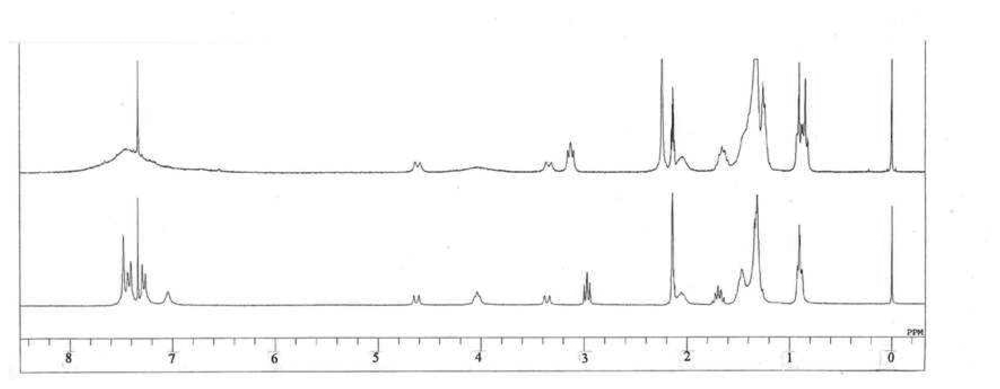

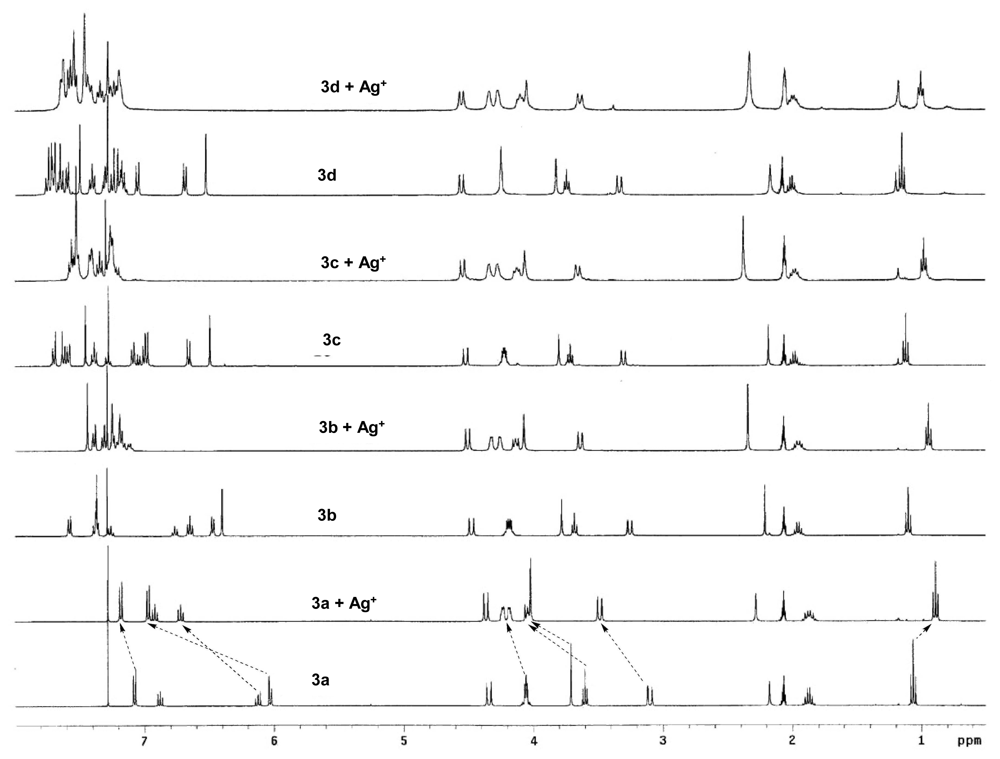
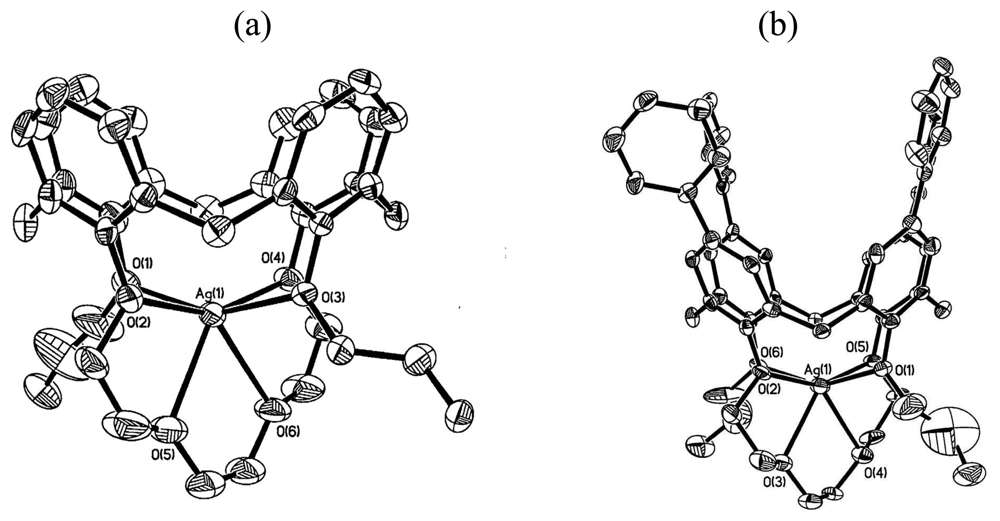

© 2008 by the authors; licensee Molecular Diversity Preservation International, Basel, Switzerland. This article is an open-access article distributed under the terms and conditions of the Creative Commons Attribution license (http://creativecommons.org/licenses/by/3.0/).
Share and Cite
Lo, P.K.; Wong, M.S. Extended Calix[4]arene-Based Receptors for Molecular Recognition and Sensing. Sensors 2008, 8, 5313-5335. https://doi.org/10.3390/s8095313
Lo PK, Wong MS. Extended Calix[4]arene-Based Receptors for Molecular Recognition and Sensing. Sensors. 2008; 8(9):5313-5335. https://doi.org/10.3390/s8095313
Chicago/Turabian StyleLo, Pik Kwan, and Man Shing Wong. 2008. "Extended Calix[4]arene-Based Receptors for Molecular Recognition and Sensing" Sensors 8, no. 9: 5313-5335. https://doi.org/10.3390/s8095313



